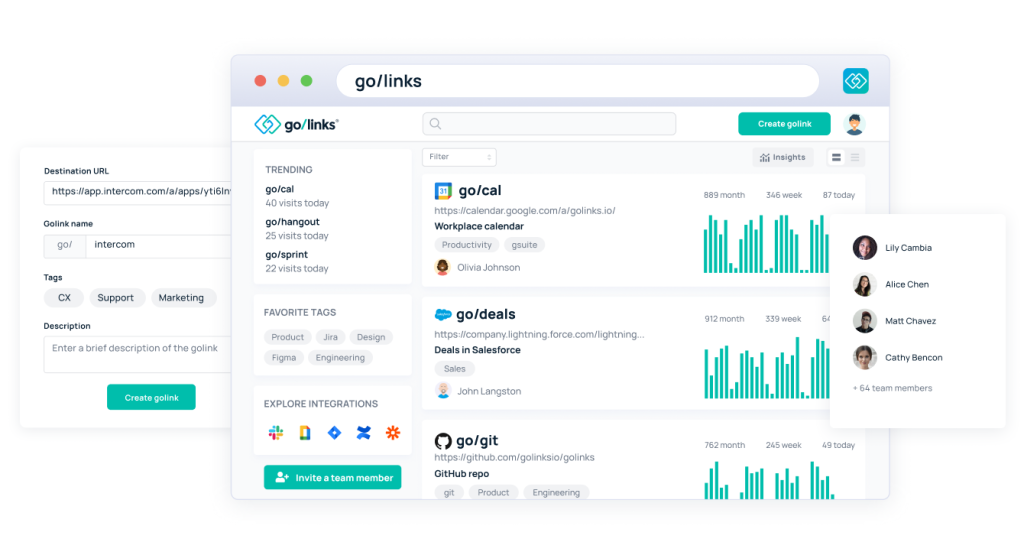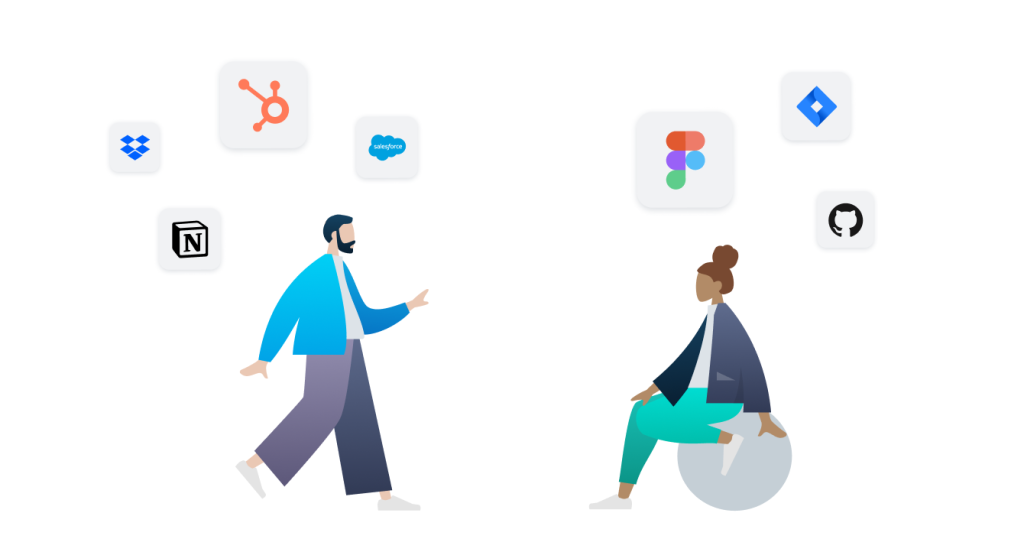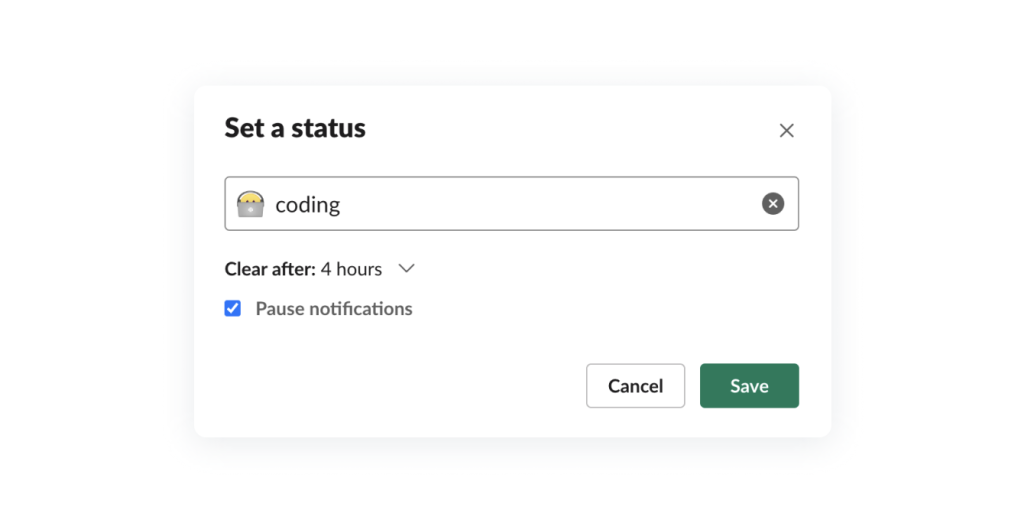Productivity problems are frustrating for every type of company, even (or especially) tech companies, which are known to innovate fast, grow even faster, and utilize every tool under the sun.
High-speed innovation and growth can quickly lead to internal process issues and lower productivity — which directly impacts your business revenue. Productivity loss isn’t cheap. According to a report by Gallup, the cost of lost productivity is $8.1 trillion per year.
So how can you combat this productivity loss? First, you need to understand what’s causing it.
The top productivity problems
We chatted with SaaS founders, technology providers, and IT consultants to learn what slows down tech companies.
Problem 1. Not being able to navigate to assets and tasks quickly
How many times have you struggled to find what you were looking for? How many times did it take you 15 minutes or more to find…?
- Design system guidelines
- An important reporting tool that you only use quarterly
- A task that you deprioritized and are now able to tackle
- Comments or mentions from earlier in the week
We’ve all been there. Because we use so many different tools, it can take quite a long time to find what we’re looking for. Of course, this kills productivity because time that could have been spent on meaningful work is now spent simply looking for things.
To solve this problem, FSN Capital uses GoLinks (that’s us!) for knowledge management.

“GoLinks put rocket engines on our collaboration efforts. For the first time, we can efficiently find and share information across the firm.”
— Christopher Conradi, Chief Digital Officer at FSN Capital
To learn more about how they used GoLinks to solve their productivity problems, read the full customer story.
Problem 2. Not aligned on objectives and key results
Another common productivity challenge at tech companies is misalignment on objectives or key results (OKRs).
Because OKRs are usually set higher than what a team can achieve, 70% satisfaction is often deemed a success. Although this is common practice, it can cause some confusion when goals that are set are never met. This can demotivate a team which in turn leads to a lack of productivity.
While OKRs are well respected and utilized by most tech companies, you might find that a different method works better for your team.
The solution can also be different levels and types of OKRs, those which are expected to be met (and can provide a sense of accomplishment), and those that are a bit loftier.
“Our top productivity problem is reaching our sales goals consistently. We have some months where we crush our sales goals and others where we barely meet half of our desired numbers. We may need to reset our sales goals to something more reasonable that we can attain at all times. In the end, I think that the problem with our sales team productivity is establishing a standard operating procedure (SOP) that we can follow at all times to achieve consistent goals.”
— Malte Scholz, CEO and Co-founder of Airfocus
If your team is only ever meeting half the goals, then it’s time to uncover the cause for the lapse of productivity and decide whether or not the goals themselves are part of the issue.
Problem 3. Knowledge workers, teams, and departments all use different apps

The consumerization of B2B tech is great for companies that offer free and affordable tools that employees can get started with all on their own. But it’s not always so great for the companies whose employees are signing up to use whatever they want to.
Employees tend to want to use the latest tech, coolest tools, and most up-to-date versions of a framework, however, that means the possibility of breaking something that is stable to introduce a new variable that can cause bugs or require refactoring.
When everyone is storing their data and working in their own platforms, things get messy. It becomes much slower to move projects forward, and IT can’t get a handle on everything used in order to integrate or downsize solutions.
“In large organizations, the number one productivity killer is the amount of interdependencies accumulated over time. Once you pass a critical threshold, there will always be some other integrated system working on their own that will stall the process. Eventually, everybody will be waiting on everybody else. The only solution is organizational, cutting the IT landscape into independent domains owned by business divisions, not IT.” — Sten Vesterli, Technology Advisor
Problem 4. Not knowing where company-wide resources are
Can you quickly and easily find your company’s sick leave policy? What about the number of vacation days you have left this year? Or the schedule for upcoming company-wide meetings or the CEO’s open office hours?
Undoubtedly, when you can’t find what you’re looking for after trying for about 10 minutes or so, you go and ask someone. Only, the problem is that the person you’re asking has plenty of work to do on their own, so you’ve just created a productivity challenge for someone else.
“From our customers, we often hear about the difficulty of finding the resources that all employees need to access, for example, 401k, health benefits, holiday schedule, events calendar, and employee handbooks. When it’s not easy to find these things, employees will often inundate their Ops or HR departments with the same questions over and over to help them locate the resources.” — Kevin Nii, GoLinks
Help everyone find what they need faster with GoLinks.

Problem 5. Meetings that are unnecessary, poorly timed, or unorganized
We all know that meetings can be a huge time suck. The problem is that you often don’t know a meeting will be a waste of time until it’s already too late.
Meetings can waste time in numerous ways:
- Wrong people in attendance, or too many unnecessary people in attendance
- Wrong timing for the meeting (can get pushed out farther to when the project is officially approved, for example)
- The meeting is unorganized and goes off-topic
“I’ve been in too many meetings that didn’t apply to me at all. Meeting organizers often blanket invite people from a team or organization. Instead, they should take the time to select the relevant team members for the meeting.” — Tyson Nichols, AWS/Linux Platform Engineer
To resolve the poorly organized meeting issue, consider whether a meeting is needed at all. Maybe the project could have taken place via async communication and collaboration in an organized chat thread or Google doc instead of a meeting.

You can also resolve meeting issues by training anyone who runs meetings on how to do it effectively. Every quarter, hold a training session on how to run meetings and make it required that everyone attend one session per year. The time your company spends in that one training session will impact the productivity of all meetings the entire year.
When people go to meetings, they often arrive with a passive attitude. It’s up to the meeting organizer to invite the right people and make sure they accomplish the agenda.
Problem 6. Speed of innovation causing technical debt
Tech companies enjoy moving fast and breaking things. It’s critical to be mindful of the technical debt you’re likely building up while you innovate. Especially for early-stage companies, technical debt can build up rapidly.
Make sure to set aside some bandwidth each quarter to resolve some of the tech debt that you’re probably racking up.
Doing a little bit extra work to clean up and organize your projects can save you hundreds of hours in the long run. One SaaS co-founder knows this issue all too well…
“The thing that has cost us more time than anything in our SaaS company is technical debt. When our product was in the early days, we were distracted by a large client project. We didn’t effectively manage our developers during that time. Three years later, we are still spending countless hours repairing code that was built back then and it often delays feature releases, sometimes up to 6 months. ” — James Rose, Co-founder of Content Snare
Problem 7. The sudden switch to hybrid or remote work
The global coronavirus forced many in-person companies into a remote working life. Especially for hardware companies, this is a major hurdle. How can these companies innovate new products, test components, or ship to customers?
“We prefer having human interactions with our team on a daily basis. It is undeniable that remote working tools have advanced, but honestly, we are more likely to solve things better and faster when we were able to do it face-to-face.” — Thành Hoàng Head of Marketing at Savincom
Even for tech software companies, the sudden WFH environment can be challenging. Not only do you have to contend with family members at home and personal distractions, but there’s also the issue of habit and preference. Some people feel more productive at the office, where they can collaborate the way that they’re used to doing.
“Right now, we’re experiencing productivity problems because our manufacturing team in Colombia is on lockdown. We’ve had to move testing to our offices in Taiwan, where we can still work in the office, but as you can imagine, moving parts for testing from one part of the world to the other doesn’t go as smoothly as one would wish.” — Eulises Quintero, Content Manager at TITOMA
Problem 8. Constant chat app distractions

Yes, chat apps are better than long emails, but they come with their own host of problems. They are distracting, and because people often expect an immediate response, they force you to choose between the meaningful work you were previously engaged in and helping a team member.
“The most common interruptions turn out to be those which should drive your productivity: email and chat applications. Both are demanding attention right when you should be focused and productive. This isn’t helped by team members who built up a technology-fueled expectation of constant availability thanks to Slack and similar tools.”— Peter Thaleikis, Software Developer
To fix this problem, you need to make it clear that people at your company are not and should not be expected to be constantly available.
Make sure that team members know how to use features to show that they are in focus mode. For example, in Slack you can set a status to “writing” or “coding,” and you can also use “do not disturb” mode. In Tandem, you can enter “focus” mode.

If you don’t set this precedent, productivity will suffer.
“We often feel like we need to answer or check a notification from Slack as soon as we get it. It’s ok to leave it there while you finish your task at hand. If someone needs to get a hold of you right this moment, they will find a way. Setting a status of something like “Coding” is a nice way of letting them know you are trying to focus.” — Tyson Nichols, AWS/Linux Platform Engineer
The worst thing that can happen is for everyone at your company to think that quickly responding to every single chat message is something to be proud of.
“Meaningful work can be interrupted with the impression of feeling busy. In large companies, the impact of the volume of chat messages and notifications on concentration is obvious. There’s no way to distinguish which instructions are urgent and what isn’t.” — Alice Bedward, Digital Marketing Specialist at Roosh
Problem 9. Context switching
While chat messages force us into continual context-switching, there are other parts of our day that have us struggling to adapt. Context switching simply means switching from one type of work to another.
Very few people remain productive when faced with repetitive, constant context switching.
“At my SaaS startup, my biggest challenge is context switching. It’s a huge challenge to get my head in the right space in order to complete each task to the best of my ability. My secret is to focus 100% on one task at a time. I do not start the next task until I tick off the previous task as complete. That way I can mentally reset.” — Matthew Johnson, General Manager of Userback.io
To combat this issue, encourage your team to organize their day in a way that batches similar tasks and projects. Other strategies include blocking out time in your calendar to focus on specific tasks, utilizing the Pomodoro technique, and better evaluating the time required to complete a specific task.
FAQs
How do you measure productivity loss within a tech company?
Measuring productivity loss within a tech company involves analyzing various metrics such as employee output, project completion rates, time spent on tasks, and overall revenue generated per unit of time. Additionally, surveys and feedback from employees can provide insights into perceived productivity levels.
What are some long-term consequences of unresolved productivity problems within a tech company?
Unresolved productivity problems within a tech company can lead to several long-term consequences, including decreased employee morale, higher turnover rates, missed market opportunities, delays in product launches, diminished customer satisfaction, and ultimately, loss of competitiveness in the industry.
How can tech companies effectively prioritize and address multiple productivity issues simultaneously?
Addressing multiple productivity issues simultaneously in a tech company requires careful prioritization and strategic planning. Companies may need to assess the urgency and impact of each issue, allocate resources accordingly, and implement solutions in a coordinated manner. Collaboration across departments and teams can also help streamline efforts to tackle multiple challenges simultaneously.
Productivity challenges will always exist. Knowing what they are is the first step to solving them.
GoLinks helps companies combat productivity problems and find what they’re looking for instantly. Get your free demo.
Access and share resources instantly with GoLinks
Try for free














